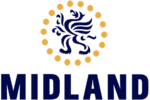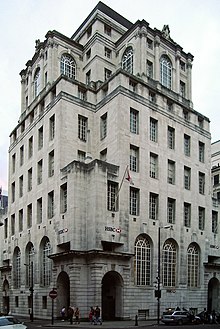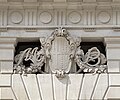 | |
 Former head office at 27 Poultry, designed in 1924 by Edwin Lutyens and built in stages until 1939 Former head office at 27 Poultry, designed in 1924 by Edwin Lutyens and built in stages until 1939 | |
| Company type | Public limited company |
|---|---|
| Industry | Financial services |
| Predecessor | North of Scotland Bank |
| Founded | 22 August 1836; 188 years ago (1836-08-22) Birmingham, England |
| Defunct | June 1999 |
| Fate | Acquired by HSBC Holdings (1992), brand retired (1999) |
| Successor | HSBC Bank Plc |
| Headquarters | 27 Poultry, London, EC2 |
| Products | Banking and insurance |
| Parent | HSBC Holdings plc |
| Website | midlandbank.co.uk archive |
Midland Bank Plc was one of the Big Four banking groups in the United Kingdom for most of the 20th century. It is now part of HSBC. The bank was founded as the Birmingham and Midland Bank in Union Street, Birmingham, England in August 1836. It expanded in the Midlands, absorbing many local banks, and merged with the Central Bank of London Ltd. in 1891, becoming the London City and Midland Bank.
After a period of nationwide expansion, including the acquisition of many smaller banks, the name Midland Bank Ltd was adopted in 1923. By 1934, it was the largest deposit bank in the world. It was listed on the London Stock Exchange, and was once a constituent of the FTSE 100 Index, but in June 1992, it was taken over by HSBC Holdings plc, which phased out the Midland Bank name by June 1999 in favour of HSBC Bank.
On 10 June 2015, HSBC announced that it would be rebranding its branches in the United Kingdom. HSBC chairman Douglas Flint described the Midland brand as "odds on favourite" for a return to the high street. In September 2015, it was announced that the Midland Bank name would not be revived, and the branch network in the United Kingdom would be branded "HSBC UK".
History
Early history



Midland Bank was founded by Charles Geach, its first manager in Union Street, Birmingham, England, in August 1836. Geach had formerly worked at the Bank of England; he secured the business support and capital backing of leading merchants and manufacturers in Birmingham.

In the 1830s and 1840s, Midland offered discounted bills of exchange for customers. By the 1850s the bank's customers included railways, iron founders and engineering concerns, utilities and municipal corporations.
Midland acquired Stourbridge Old Bank in 1851 and Nichols, Baker and Crane of Bewdley in 1862.
Acquisitions and development in its first 50 years
From the 1880s, it expanded its customer base by opening new branches and acquiring other banks. In 1891 it acquired the Central Bank of London (which gave Midland a seat in the London Bankers' Clearing House, in 1898 it bought the City Bank (which provided a London head office), in 1901 it acquired the Sheffield Union Bank, in 1913 the Sheffield and Hallamshire Bank and, in 1914, it acquired the Birmingham Banking Company.
By 1918, with deposits of £335 million, it ranked as the largest bank in the world. Edward Hopkinson Holden led the bank at this time first as managing director from 1898 to 1908 and then as chairman and managing director from 1908 until his death in 1919. He oversaw more than twenty bank amalgamations between 1891 and 1918, and opened new branches throughout England and Wales.
Holden also expanded overseas; it was the first British bank to set up a foreign exchange department and, by 1919, it was acting as London bank to some 650 correspondent banks throughout the world. From 1907, these correspondents included The Hongkong and Shanghai Banking Corporation.
After the First World War, the leading British banks entered an agreement with the government that they would not attempt further amalgamations without Treasury approval. As a result, Midland turned its attention to expanding its branch network, adding new banking services, mechanising its systems (from 1928) and advertising its activities.
Post-war recovery and international alliances
Midland responded to the ending of credit restrictions in 1958, by extending its branch network and by introducing a series of innovative services, including personal loans (1958), personal cheque accounts (1958) and cheque cards (1966). In 1958, it acquired Forward Trust, which became a leader in instalment finance, leasing and factoring services.
In 1967, Midland acquired a share in Montagu Trust, the owner of Samuel Montagu & Co., and thereby became the first British clearing bank to own a London merchant bank. Samuel Montagu, with its own history dating back to 1853, became a wholly owned subsidiary in 1974, and is now part of HSBC's private banking business.
Through the acquisition of Samuel Montagu & Co, Midland also gained a majority share in Guyerzeller Bank AG (now HSBC Guyerzeller Bank) in Switzerland. Further diversification followed in 1972, when Midland was the leading member of the consortium that acquired the Thomas Cook travel business. After becoming sole owner in 1977, Midland sold its interest in 1992.
In 1974, Midland began to open branches or representative offices in overseas countries and to acquire other international banks. The largest of these was the purchase of a majority share in Crocker National of California, United States: this was not a success and Midland was forced to take full ownership in 1985 so that it could sell it to Wells Fargo the following year.
In 1980, Midland acquired a controlling interest in Trinkaus & Burkhardt KGaA, a private bank in Germany with a long history of its own, today HSBC Trinkaus.
In 1984, in a bid to grab market share Midland scrapped current account charges. It was so successful that all other banks in the United Kingdom had to quickly follow and offer the same or risk losing their customers. The country has had free banking ever since.
Midland joins the HSBC Group
The Hongkong and Shanghai Banking Corporation acquired a 14.9% equity interest in Midland Bank in 1987, and a strong working relationship developed. In October 1989, First Direct was established and was at the forefront of telephone banking, with person to person service available twenty four hours a day, 365 days a year.
In June 1992, following a brief bidding war with Lloyds Bank, HSBC Holdings plc acquired full ownership of Midland Bank. At the time, it was one of the largest acquisitions in banking history, and gave HSBC a major foothold in Europe, which it needed to complement its existing business in Asia and the Americas, when it had to move its Hong Kong–based headquarters to London on 1 January 1993, accepting primary banking supervision by the Bank of England.
In 1997, Midland Bank underwent a total rebrand to match its parent company, with its familiar griffin logo being dropped after 32 years in favour of the HSBC "hexagon" symbol, albeit with the "Midland Bank" name placed next to it. Midland Bank was renamed HSBC Bank in June 1999, as part of the adoption of the HSBC brand throughout the Group. Prior to this, a Midland Bank branch in Croydon became the first to bear the HSBC name in the UK, albeit with "Midland Bank plc" still featuring on the plaque near the entrance.
The last head office of Midland Bank, opposite the Bank of England in Poultry and Princes Street, was sold in October 2006 to a tycoon from Russia, with HSBC vacating the banking hall on the ground floor and huge underground deposit vaults in 2007. In 2012 the ground floor was used in the Channel 4 game show The Bank Job. The architect John Alfred Gotch designed the building, with assistance from Sir Edwin Lutyens.
Built between 1921 and 1939, and symbol of the 1930s pride of the biggest bank in the world, the building is now The Ned Hotel City of London.
Until around 2020, the HSBC UK SWIFT code (all offices in the United Kingdom) remained MIDLGB22, reflecting its past as the Midland Bank.
Branding
Midland Bank was famous for its golden griffin logo, surrounded by golden coins originally introduced in 1965 on a black, then later blue background, and for its slogan "the listening bank", written by the advertising executive Rod Allen. Advertisements for the bank appeared in the popular computer game Theme Park. An animated friendly version of the Griffin fronted the bank's television advertising during the 1980s.
Midland Bank still traded as Midland Bank, but started adopting an HSBC byline by the early 1990s, started using the HSBC logo from 1997, and was finally rebranded as HSBC Bank in June 1999, as part of the adoption of the HSBC brand throughout the group. However, a dormant subsidiary, Midland Bank (Branch Nominees) Limited, continues to be registered at Companies House.
-
 Coat of arms and initials of Midland Bank in the 1930s, above its side entrance on Princes Street, London
Coat of arms and initials of Midland Bank in the 1930s, above its side entrance on Princes Street, London
- [REDACTED] First "griffin" logo, used from 1957 to 1988
- [REDACTED] Second "griffin" logo used from 1988 to 1997
- [REDACTED] Final logo used from 1997 to 1999 (HSBC logo with "Midland Bank" name)
References
- "Midland Bank, Poultry". Know Your London. 23 November 2020. Archived from the original on 26 May 2023. Retrieved 26 May 2023.
- "Midland Bank". Claxity. 10 June 2019. Archived from the original on 26 May 2023. Retrieved 26 May 2023.
- Titcomb, James (12 June 2015). "Is this the new name for HSBC? Chairman says former brand Midland is 'odds-on favourite'". telegraph.co.uk. Telegraph. Archived from the original on 4 December 2015. Retrieved 3 December 2016.
- Cartledge, James (3 September 2015). "No return for Midland Bank name, HSBC confirms". birminghammail.co.uk. Birmingham Mail. Retrieved 3 December 2016.
- ^ HSBC Group in Europe Archived 2011-09-27 at the Wayback Machine
- "Birmingham Banking Company Records - Archives Hub". Archives Hub. Retrieved 9 July 2020.
- Philip Aldrick (24 May 2012). "Free banking should end Bank official says". telegraph.co.uk. telegraph. Archived from the original on 14 June 2018. Retrieved 12 November 2016.
- James Titcomb (3 January 2015). "You may not know it, but you are paying for your bank". telegraph.co.uk. telegraph. Archived from the original on 14 June 2018. Retrieved 12 November 2016.
- "Russian tycoon buys former Midland HQ". Archived from the original on 12 June 2011. Retrieved 26 December 2008.
- "The Ned | A 5 Star Hotel in the City of London". www.thened.com. Archived from the original on 13 August 2022. Retrieved 13 August 2022.
- "Swift Code (BIC) - MIDLGB22 XXX - HSBC BANK PLC (ALL U.K. OFFICES)". Bank-codes.com. Retrieved 3 December 2016.
- "Midland Bank return: Remember the adverts and gifts that made you save your pennies?". 9 June 2015. Archived from the original on 24 September 2020. Retrieved 22 December 2020.
- No. 239325, incorporated 6 May 1929
External links
- Archived website
- Documents and clippings about Midland Bank in the 20th Century Press Archives of the ZBW
| [REDACTED] HSBC | ||
|---|---|---|
| Origin | [REDACTED] | |
| Board of directors | ||
| Brands | ||
| Principal local banks | ||
| Subsidiary banks | ||
| Minority stakes and JVs |
| |
| Predecessor companies |
| |
| Former local banks | ||
| Former subsidiaries | ||
| Scandals | ||
- "SWIFT Code (BIC), MIDLGB22, MIDLGB22XXX, HSBC BANK PLC (ALL U.K. OFFICES), UNITED KINGDOM". www.allbankswiftcodes.com. Retrieved 4 February 2018.
- 1836 establishments in England
- 1999 disestablishments in England
- Banks established in 1836
- Banks disestablished in 1999
- Defunct companies based in Birmingham, West Midlands
- Companies formerly listed on the London Stock Exchange
- Defunct banks of the United Kingdom
- History of Birmingham, West Midlands
- HSBC acquisitions
- British companies disestablished in 1999
- British companies established in 1836
- 1990 mergers and acquisitions